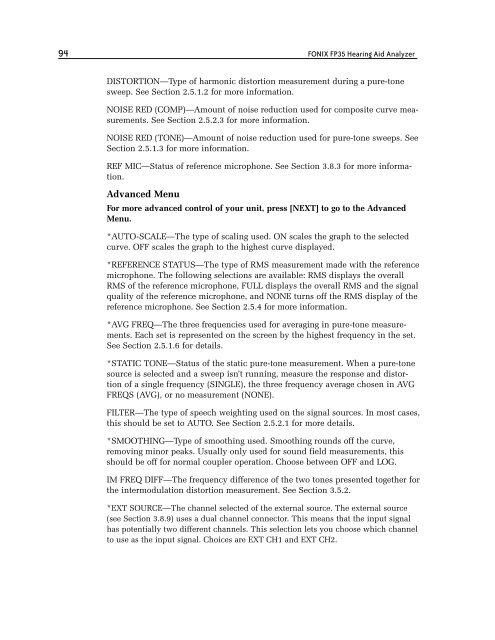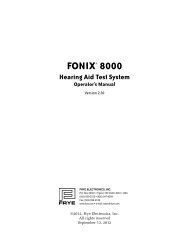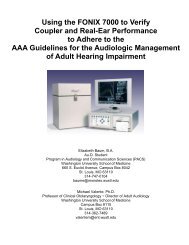FONIX® FP35 Touch - Frye Electronics
FONIX® FP35 Touch - Frye Electronics
FONIX® FP35 Touch - Frye Electronics
You also want an ePaper? Increase the reach of your titles
YUMPU automatically turns print PDFs into web optimized ePapers that Google loves.
94 FONIX <strong>FP35</strong> Hearing Aid Analyzer<br />
DISTORTION—Type of harmonic distortion measurement during a pure-tone<br />
sweep. See Section 2.5.1.2 for more information.<br />
NOISE RED (COMP)—Amount of noise reduction used for composite curve measurements.<br />
See Section 2.5.2.3 for more information.<br />
NOISE RED (TONE)—Amount of noise reduction used for pure-tone sweeps. See<br />
Section 2.5.1.3 for more information.<br />
REF MIC—Status of reference microphone. See Section 3.8.3 for more information.<br />
Advanced Menu<br />
For more advanced control of your unit, press [NEXT] to go to the Advanced<br />
Menu.<br />
*AUTO-SCALE—The type of scaling used. ON scales the graph to the selected<br />
curve. OFF scales the graph to the highest curve displayed.<br />
*REFERENCE STATUS—The type of RMS measurement made with the reference<br />
microphone. The following selections are available: RMS displays the overall<br />
RMS of the reference microphone, FULL displays the overall RMS and the signal<br />
quality of the reference microphone, and NONE turns off the RMS display of the<br />
reference microphone. See Section 2.5.4 for more information.<br />
*AVG FREQ—The three frequencies used for averaging in pure-tone measurements.<br />
Each set is represented on the screen by the highest frequency in the set.<br />
See Section 2.5.1.6 for details.<br />
*STATIC TONE—Status of the static pure-tone measurement. When a pure-tone<br />
source is selected and a sweep isn’t running, measure the response and distortion<br />
of a single frequency (SINGLE), the three frequency average chosen in AVG<br />
FREQS (AVG), or no measurement (NONE).<br />
FILTER—The type of speech weighting used on the signal sources. In most cases,<br />
this should be set to AUTO. See Section 2.5.2.1 for more details.<br />
*SMOOTHING—Type of smoothing used. Smoothing rounds off the curve,<br />
removing minor peaks. Usually only used for sound field measurements, this<br />
should be off for normal coupler operation. Choose between OFF and LOG.<br />
IM FREQ DIFF—The frequency difference of the two tones presented together for<br />
the intermodulation distortion measurement. See Section 3.5.2.<br />
*EXT SOURCE—The channel selected of the external source. The external source<br />
(see Section 3.8.9) uses a dual channel connector. This means that the input signal<br />
has potentially two different channels. This selection lets you choose which channel<br />
to use as the input signal. Choices are EXT CH1 and EXT CH2.
















